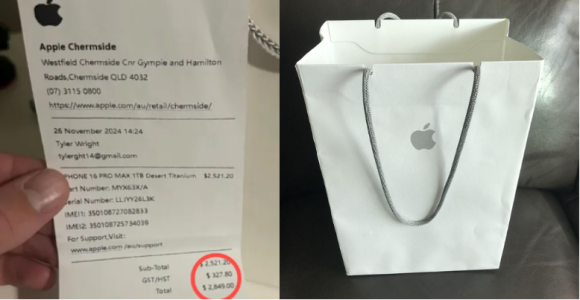Would you have spotted the red flag on this $2,849 receipt? This man didn’t—and it nearly cost him big
By
Maan
- Replies 9
Online shopping can be incredibly convenient—but it also comes with hidden risks, especially on second-hand platforms.
What began as a promising deal on a brand-new device quickly turned into a case of suspicious details and unexpected red flags.
What unfolded next serves as a timely reminder to stay vigilant when scrolling through listings that seem just a little too good to be true.
Online marketplaces have become a treasure trove for savvy shoppers—offering everything from homewares to high-end tech at seemingly irresistible prices.
But behind some of those glossy product photos and detailed descriptions, things aren’t always what they seem.
One Victorian shopper recently discovered just how convincing a scam can look when they came across what appeared to be an iPhone 16 Pro listed for sale.
The listing ticked all the boxes: it claimed the phone came from a legitimate Apple store in Queensland, and the seller even provided a receipt to back up their story.
At first glance, the proof of purchase looked completely above board. It had the store name, the purchase date, the device specifications—even the serial number and IMEI were included.
But a closer inspection told a different story.
The receipt claimed the phone had been bought in November for $2,849. The retail price was listed as $2,521.50, and a GST of $327.80 had apparently been added on top. That figure, however, raised eyebrows.
GST in Australia is typically 10 per cent of the cost, which would have worked out to just $252.15. The numbers simply didn’t add up.
Still, that wasn’t the most glaring red flag.
Further down on the receipt, it read: ‘Paid Visa commonwealth banking’.
Not only was the formatting awkward, but it also featured a major error—Apple receipts generally list the payment method as either Visa or Mastercard, and don’t name the bank at all. And if they did, it would be properly spelled as Commonwealth Bank.
While the top portion of the document looked polished and accurate, the fine details painted a very different picture—one that suggested this was far from a legitimate purchase.
This case served as a cautionary tale for anyone scrolling through listings on social media. As tempting as a good deal might be, it pays to double-check the details—and trust your gut if something feels off.
Scams are getting smarter—and fake receipts are just the beginning.
Watch how this new tech trickery could affect anyone trying to spot what’s real from what’s not.
Source: Youtube/10 News

Have you ever spotted something dodgy while shopping online but weren’t sure whether to speak up or walk away? Let us know your thoughts in the comments.
In a previous story, we looked at the dangers of online transactions when one man was seriously injured in a social media Marketplace scam.
For seniors who value safety as much as a good bargain, it’s a stark reminder that not every seller has good intentions.
If you’ve ever felt uneasy about meeting someone to buy or sell an item, that story is worth a look too.
Read more: Man suffers serious injuries in Facebook Marketplace scam gone wrong
What began as a promising deal on a brand-new device quickly turned into a case of suspicious details and unexpected red flags.
What unfolded next serves as a timely reminder to stay vigilant when scrolling through listings that seem just a little too good to be true.
But behind some of those glossy product photos and detailed descriptions, things aren’t always what they seem.
One Victorian shopper recently discovered just how convincing a scam can look when they came across what appeared to be an iPhone 16 Pro listed for sale.
The listing ticked all the boxes: it claimed the phone came from a legitimate Apple store in Queensland, and the seller even provided a receipt to back up their story.
At first glance, the proof of purchase looked completely above board. It had the store name, the purchase date, the device specifications—even the serial number and IMEI were included.
But a closer inspection told a different story.
The receipt claimed the phone had been bought in November for $2,849. The retail price was listed as $2,521.50, and a GST of $327.80 had apparently been added on top. That figure, however, raised eyebrows.
GST in Australia is typically 10 per cent of the cost, which would have worked out to just $252.15. The numbers simply didn’t add up.
Still, that wasn’t the most glaring red flag.
Further down on the receipt, it read: ‘Paid Visa commonwealth banking’.
Not only was the formatting awkward, but it also featured a major error—Apple receipts generally list the payment method as either Visa or Mastercard, and don’t name the bank at all. And if they did, it would be properly spelled as Commonwealth Bank.
While the top portion of the document looked polished and accurate, the fine details painted a very different picture—one that suggested this was far from a legitimate purchase.
This case served as a cautionary tale for anyone scrolling through listings on social media. As tempting as a good deal might be, it pays to double-check the details—and trust your gut if something feels off.
Scams are getting smarter—and fake receipts are just the beginning.
Watch how this new tech trickery could affect anyone trying to spot what’s real from what’s not.
Source: Youtube/10 News
Key Takeaways
- A Victorian shopper found an *iPhone 16 Pro* listing on social media that came with a convincing but suspicious receipt.
- The receipt showed a GST charge of \$327.80, which was too high for a \$2,521.50 phone.
- A key error on the receipt read ‘Paid Visa commonwealth banking’ instead of just listing a standard payment method.
- The fake receipt highlighted the importance of scrutinising online deals that seem too good to be true.
Have you ever spotted something dodgy while shopping online but weren’t sure whether to speak up or walk away? Let us know your thoughts in the comments.
In a previous story, we looked at the dangers of online transactions when one man was seriously injured in a social media Marketplace scam.
For seniors who value safety as much as a good bargain, it’s a stark reminder that not every seller has good intentions.
If you’ve ever felt uneasy about meeting someone to buy or sell an item, that story is worth a look too.
Read more: Man suffers serious injuries in Facebook Marketplace scam gone wrong







